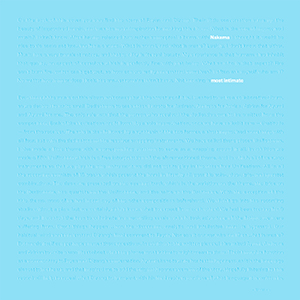 Grand Line, Nakama’s last release and the project’s second overall, was a sometimes-chaotic mass of free jazz improvisations held together by a structured sense of composition that seemed to be at odds with the music itself. Most Intimate has a similarly focused conceptual foundation, but rather than the grand gestures of the last album, here they are much more personal, with the quartet members each writing parts for one another to play. The concept is admittedly complex and convoluted, but in execution it works in more ways than just being a novelty.
Grand Line, Nakama’s last release and the project’s second overall, was a sometimes-chaotic mass of free jazz improvisations held together by a structured sense of composition that seemed to be at odds with the music itself. Most Intimate has a similarly focused conceptual foundation, but rather than the grand gestures of the last album, here they are much more personal, with the quartet members each writing parts for one another to play. The concept is admittedly complex and convoluted, but in execution it works in more ways than just being a novelty.
Most Intimate is made up of a series of "Dedications," "Gratitudes," and "Unifications."The dedication pieces involved one member of the quartet writing a piece in honor of another member, with the caveat that the performer receiving the dedication did not perform.The subsequent gratitude piece is that recipient playing a solo performance in response.Finally, the unification is a performance by the full quartet, but with the person giving the dedication and the person receiving swapping instruments.This is bookended by two full band pieces, and an improvisation in the middle where the members play the instrument they did not in one of the previous arrangements.
Yes, it is complex enough that a diagram or a flow chart could have been provided to specify all of these varying arrangements, but it really is unnecessary to appreciate the album.Unsurprisingly the opening and closing pieces ("Intimate" and "Most Intimate", respectively) are the most traditionally composed and rich sounding, with not only all performers involved, but also playing their preferred instruments (as duos).For "Intimate" a slow, intentionally repetitive passage of Christian Meaas Svendsen's bass and Adrian L√∏seth Waade's violin as first establishing a rhythm, with Ayumi Tanaka's piano adding a delicate counterpart.Percussionist Andreas Wildhagen's contribution is a sparse, but effective passage of cymbal playing.Concluding "Most Intimate" is less of an insistent rhythm and more of an expansive piece of music.Driven by piano and violin, with the bass and percussion being more of an accent, there is a gentle peacefulness to the piece that is subtle and light without being insubstantial.
The first "Dedication" piece, omitting percussion, is also an extremely graceful sounding work, one that at times drifts precariously close to an easy listening jazz sound, but never crosses that line.The following "Gratitude" piece is therefore a performance for solo drums and has Wildhagen doing a lot with just a standard kit.With the toms played lightly enough to have a resonating melodic quality to them, there is significant depth to the solo, and the exceptionally high quality recording really helps magnify these subtleties.The short "Unification" that follows has a higher tempo and a looser, more urgent improvised sound that at times drifts nicely into more abrasive territory.
The rest of the album follows this model, with the violin-less "Dedication II" taking on percussive throb that makes it stand out, both from rattling snare drums and more aggressive piano with a more aggressive sound.It is followed by the violin solo "Gratitude II" featuring L√∏seth Waade's instrument played in mostly unconventional ways, such as sharp string bowing or muted plucks."Gratitude III" omits the piano and in turn becomes a less melodic, slowly building rhythmic piece, and Meaas Svendsen's subtle vibrations of "Gratitude IV" compliments the spacious and delicate preceding "Dedication IV" very well.
Nakama is all about conceptual complexity, and Most Intimate is no different.However, it is not necessary to fully appreciate the album.My first listen was actually without any knowledge of the underlying theory and structure used, and I found it enjoyable just on that superficial level.The varying arrangements make for a diverse sound, mostly following a pattern of a more open sounding piece, then a solo, then a full band improvisation that has a distinct rawness to it likely magnified by the fact that half of the band are not on their primary instruments.With that alone it is a wonderful album of pieces of varying complexity, and the knowledge of how it was conceived is just an extra dimension to appreciate.
samples: